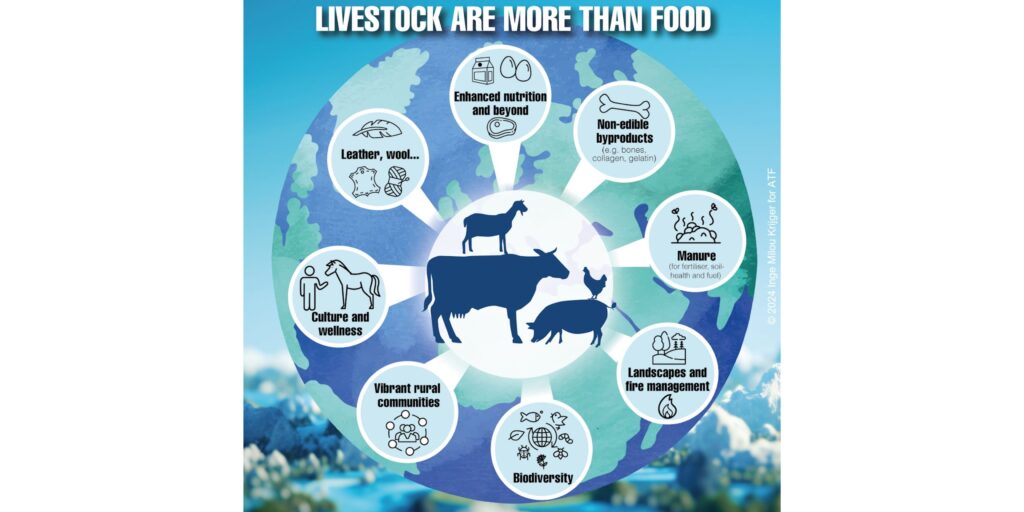20 November 2024 - Join us at the 14th ATF seminar
Livestock are more than food

Provisional programme
In the context of climate change, measurement of the use of animal resources in all its components is a key question. It includes the use of animal products for human food consumption but also many other uses: fibre, feed, energy, manure for fertilisation, biodiversity and fire management, enhanced nutrition, insulation of houses, medical intervention, drugs production as well as culture and vibrant rural communities.
All these uses, in addition to food, contribute to the closing of the biological cycle, and are key points to reduce waste and valorise the contribution of animal production to the circular bioeconomy. Some of them, like manure, fibre and drug production are alternatives to the use of fossil resources and contribute significatively to improving the climate balance of animal production.
The theme covers all the species and involves all the actors including production, industry, and the co-product valorization sector.
- Assessment methods to estimate all these non-food use benefits with the appropriate measurement tool;
- Demonstration of the contribution of these non-food uses to the overall balance of animal production and energy consumption or greenhouse gas emissions;
- Fields of research necessary to increase the benefit of non-food use of animal product;
Estimation of synergies and trade-offs between food and the other valorizations; - Compatibility of these uses with health and food security (the spectra of BSE is still present in the public opinion);
- Wool, leather, fur, feathers: clothes, bags, equipment’s, insulation for houses or cars…
- By product of slaughtering: fat, protein, bones, and product extracted (collagen, gelatin (cooking))
- Methane or biogas production as a renewable energy source
- Manure to fertilise the soils
- Landscape management (forest fire, avalanches); effect on soil with pasture and trampling
- Eco-shepherding in the towns
- Used as a mediator in certain mental illnesses (autism…)
- Support of human culture (cf. classification of transhumance on patrimony of UNESCO)…
- Animal traction: skidding (forest preservation); local transportation in some villages or towns for example for waste bin or children to school…
9:00 | Welcome & introduction By Frank O’Mara, ATF President – @FrankOMara8 |
9:05 | Outcomes of the ATF-EAAP LFS Symposium, 01 September 2024: Important messages and gaps in the discussion By Ana Sofia Santos, ATF – @SofiaSantosAna |
9:20 | Public policies: vision policy maker By Carlos Martin Ovilo, DG Agri/European Commission – @EUAgri |
9:40 | Life cycle and ecosystem services assessments provide opposite evaluations of the food and non-food contributions of livestock farming systems By Frédéric Joly, INRAE – @INRAE_France @JolyFrdric4 |
9:55 | Contribution of the livestock sector to the pet food industry By Alice Tempel Costa, FEDIAF – @FEDIAF_PetFood |
10:10 | The importance of animal manures for the biogas / biomethane industry By Lucile Sever, European Biogas Association – @European_Biogas |
10:25 | Importance of livestock to the gelatine sector: challenges, needs and future perspectives By Line Jensen & Dennis Witthöft, GME – Gelatine Manufacturers of Europe |
10:40 | Coffee break |
11:00 | Contribution of the livestock sector to textiles – wool By Dalena White, IWTO – @iwto_wool |
11:10 | Role of livestock in circular bioeconomy systems (FAO report) |
11:30 | Daroeira Farm: An Integrated Agrifood and Environmental System By Manuel Chaveiro Soares, Portugal |
11:45 | Lampela Dairy farm: keeping the countryside alive and productive By Perttu Sirviö, Finland |
12:00 | Panel discussion |
13:00 | Closing remarks By Frank O’Mara, ATF President – @FrankOMara8 |
